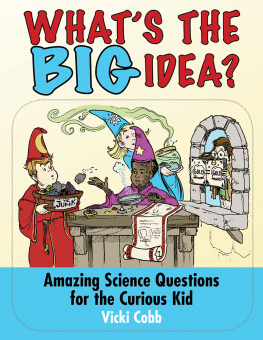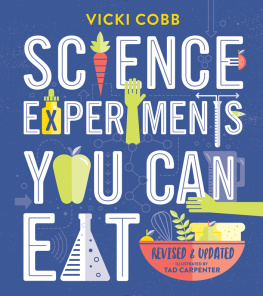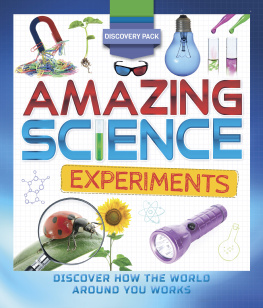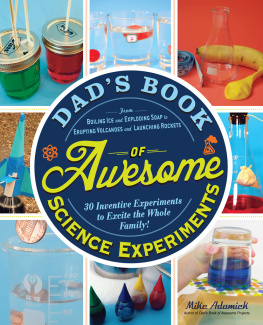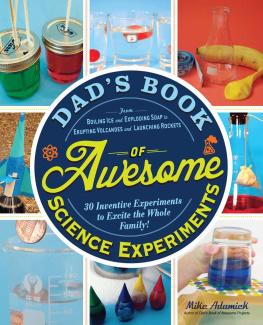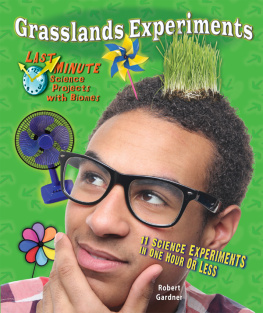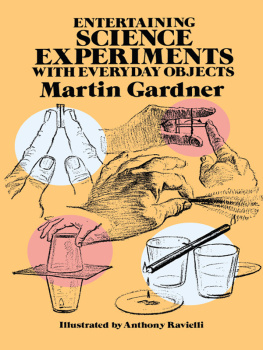ACKNOWLEDGMENTS
The author gratefully acknowledges the help of the following people: Dr. Marcia Pelchat, Monell Chemical Senses Center; David Landrigan for the blob figures; Dr. Matthew M. Botvinick for the Real Rubber Arm illusion; Dr. Barry Green of The John B. Pierce Laboratory, Yale University for the Cold Fooler experiment; Dr. Eric H. Chudler of the University of Washington for the sidedness experiment; Mike Swift of Whirley Industries; The American Chemical Society for the Vegetable Dye procedure that appeared in Vol. 5, May 1991; consummate science teacher Ed Escudero of Summit County School for sources and science procedures too numerous to mention. A special thanks to my game assistant, Ned Stuart, who was always ready to experiment; to my marvelously enthusiastic editor, Kate Waters, for her attention to detail and buoyant support; and to my husband, Richard Trachtenberg, who nods silently to my constant enthusing over science experiments.
Art on page 29 adapted with permission from The Best of Science , The American Chemical Society, 1997.
Some of the material in this book has been previously published.
CHAPTER 1
Yourself and Other Humans
Y ou and your friends are fascinating subjects for scientists. Human beings are the most complicated of all living things with the most highly developed nervous systems, including our amazing brains. How we get information about the world we live in, how we process that information, and how we respond to it makes us who we are. But if we are so complicated, how can we gain understanding of how we tick?
Fortunately for scientists, we have weaknesses. Our senses are limited and can be fooled. Illusions are clues that can reveal ways your nervous system works. Its fun and enlightening to test the limits of your perceptions. Youve got plenty. In this chapter youll discover some peculiarly odd and interesting things about yourself and your friends. Get ready for some amazing yet humbling experiences.
THE TRIANGLE TEST
MATERIALS AND EQUIPMENT
- scissors
- coffee filter paper
- ruler
- sharp knife
- lemon
- lime
- spoon
- pencil
- a blindfolded friend without a cold
D o you have a talented nose? Can you tell the difference between two closely related smells? Can you remember what you smell? The triangle test is given to job applicants in the perfume and fragrance industry to see how well they smell. Test yourself and your friends.
Method of Instigation
- Cut the coffee filter paper into strips about inch wide and 3 inches long. You need three strips for each test. Thats why its called the triangle test.
- Transfer the oils, which contain the molecules you smell, from the citrus fruit to the end of the test strips. To do this, cut a piece of lemon peel and a piece of lime peel. Place the peel, outside skin side down, on the end of a strip of filter paper. Press the peel over the strip with the back of a spoon to squeeze its oil onto the filter paper. Make one lemon oil strip, one lime oil strip, and either one for the third strip. Number the ends of the strips so you know which is which.
- Tell a blindfolded friend that you are going to present three smells and to tell you which two are alike. As you hold a strip under your friends nose, state the number. Do three trials for the test, alternating the order in which you present the strips. To refresh the nose between sniffs, have your friend sniff a tissue or a sleeve.
Observations & Suggestions
Have your friend try the triangle test on you. Do the triangle test on lots of people: Are females more talented smellers than males? Are adults better smellers than children? Test two brands of coffee, two different perfumes, apricots and nectarines, almond extract and cherry extract, or the cooking water of broccoli and cauliflower.
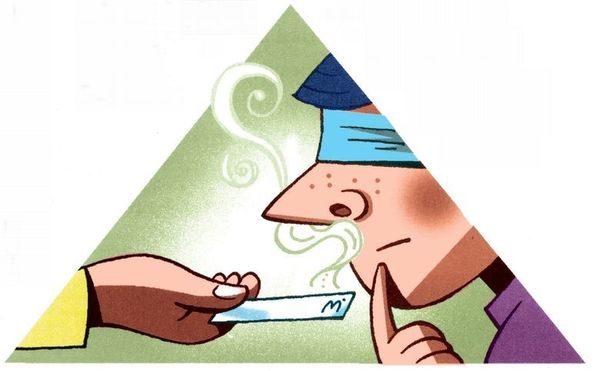
YOUR INTERNAL SENSE OF TOUCH
Meeting Fingertips (pg. 11) Mirror Writing (pg. 12) Do You Want to Be a
Helicopter Pilot? (pg. 12) Zeroing In (pg. 13)
C lose your eyes and imagine the position of your body at this moment. You know where your legs and arms and hands are. You know if you are sitting or standing. Your ability to sense your body and its motions is called proprioception . Talented athletes and dancers have a heightened proprioceptive sense. Learning to dance, to type, or to play a musical instrument or a sport, for example, involves practice. Repeated motions train your proprioceptive nerves so that eventually you have a muscle memory. You can repeat the motion without thinking about it.
Here are some simple activities that investigate your proprioceptive sense.
MEETING FINGERTIPS
H ow good are you at touching your index fingers together? Here are a few tests that make a challenge out of a no-brainer.
Method of Investigation
- Stand up and extend your arms sideways. Rotate your extended arms from your shoulders three times. Now close your eyes and try to get your fingertips to meet without going past each other.
- With your eyes open, try this again using pencils pointing directly at each other. Are you more or less accurate with the pencil points than with your fingers? Try again, this time keeping one eye closed. Then try with both eyes closed.
- Close your eyes and raise both hands over your head. Keep your left hand perfectly still. Touch the tip of your nose with the index fingertip of your right hand. Quickly try and touch the thumb of your left hand (which is still over your head) with your right index fingertip. Try this motion several times, first touching your nose and then attempting to touch your left thumb.
Observations & Suggestions
Do you improve with practice? Does it make a difference when you switch hands? What happens when you wiggle your fingers? Does wiggling help your proprioceptive sense to locate your thumb in space?
MIRROR WRITING
C an you write backward? Try writing a sentence while looking at your writing hand in a mirror. This is nearly impossible because vision dominates your proprioceptive sense. Moving your hand from left to right is difficult because youre seeing it in reverse in the mirror.
Method of Investigation
You can actually fool your proprioceptive sense into doing mirror writing. Place a half sheet of paper on your forehead. Hold it in place with your nonwriting hand. Holding a pencil with your other hand, place the point on the left side of your forehead. Then write your name or a word such as hello in cursive script going from left to right across your forehead. Imagine the page is in front of you and that you are writing normally. Dont think too hard about what youre doing. When you look at what youve written, it appears illegible. But if you look at it in a mirror, or if you turn the paper over and hold it up to the light, it can be easily read.
DO YOU WANT TO BE A HELICOPTER PILOT?



